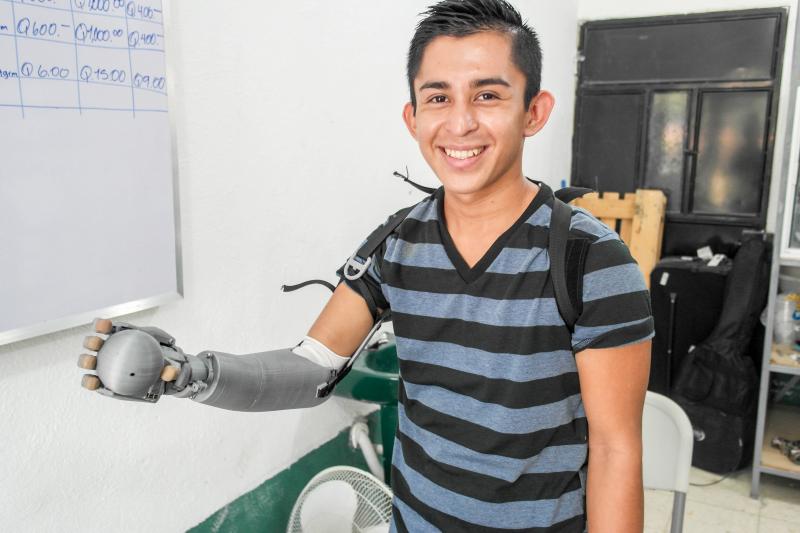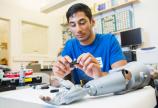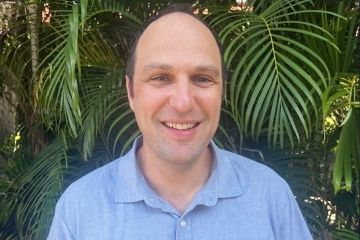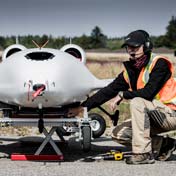Within reach
- Michelle Wright

Compassion and technology combine to make better replacement limbs.
From the autumn 2015 UVic Torch Alumni Magazine.
Michelle Wright, BSc ’99
Nick Dechev walked into the rehabilitation section of a Toronto hospital back in 1996 and what he saw left him, a young engineering grad student, in shock. Instead of employing the latest technology, he saw prosthetic hands and arms that looked liked they were leftover from the 1940s. “In Hollywood, you see the Terminator, Star Wars, Luke Skywalker’s hand, and then…” says Dechev, his voice trailing off. “I was appalled.”
Amputees tend to be economically disadvantaged, particularly in the developing countries where roughly 80 per cent of the world’s amputees live. “I realized it was the economics of it,” says Dechev. “People just…they don’t care.” No one was interested in pumping money into research and development when the only guarantee in the prosthetic market was a limited financial return. Dechev saw a challenge, an obvious need, and thought, “I am going to do this.”
Dechev’s roots are in Vancouver’s West End, where he spent his summers as a delivery driver, selling apples and cherries from his parents’ fruit stall. But he’s always been a builder at heart, making little machines and gadgetry from early on. “A machine designer,” says Dechev, “that is what I am, through and through. I’ve always been fascinated with hands and biomechanics. I can’t even remember from when.”
Today, Dr. Nikolai Dechev leads a growing team of 16 researchers and students. He also manages the Victoria Hand Project (VHP), a not-for-profit organization hell-bent on designing and distributing low-cost, high-function, upper-limb prostheses to those in need, particularly in Guatemala and Nepal.
Home base is UVic’s Biomedical Design and Systems Laboratory. The lab has a cool, active vibe. A large table in the centre of the room is mostly covered in tools, parts and prosthetic limbs of various makes and models. There are remnants of a late-night work party: empty pop cans, an open bag of Doritos. Absent are the guitar and Nerf guns, rumoured to have left the lab for Nepal, along with hand designer Joshua “I try to keep the lab fun” Coutts, BEng ’14.
Coutts and wrist designer Pranay Shrestha, BEng ’15, get much of the credit for the design and development of the Victoria Hand—a strong, functional, lightweight, aesthetically pleasing and dramatically affordable prosthesis.
The VH is based on one of Dechev’s earlier designs that was resurrected in 2013 after the arrival of cheap, high performance 3D printers. But would a 3D printer be capable of creating a durable and functional product, rather than a simple static model? “Being a machinist, I was kind of pessimistic,” says Dechev. But Coutts, with his background in mechatronics (a combination of skills that includes mechanical and electrical engineering) and his experience with 3D printing, was more optimistic.
Disappointing initial results—like brittle finger links—finally gave way to a high quality prosthetic hand that could be printed with speed and strength. With money in the bank, courtesy of a grant from Grand Challenges Canada, Dechev found himself thinking, “This is going to work. This can actually happen.”
Dechev joined up with two prosthetic care providers in developing countries: the Range of Motion Project in Guatemala and the Nepal Orthopedic Hospital. Tests and trials provided valuable feedback and design improvements. So far, tests have been completed with a dozen people with limb differences in Guatemala and another four in Nepal. Final trials are planned for early next year, with the hope of putting them into permanent use soon after.
Dechev holds out a series of skin-toned, plastic blocks — something like the multi-coloured swatches found in a paint store — explaining that an aesthetically pleasing prosthetic is also important. “It’s a big deal,” says Dechev, “bigger than we thought.”
For Coutts, what began as a co-op work term position has evolved into something much more than a job. “It’s not just a project. It’s a lifestyle,” he says/ He spent part of the summer in Nepal, on his own dime. The grant funding has run dry but Coutts’ passion for the cause has not. “I am not just going to get up and leave.”
“Interacting with the amputees has been very motivating,” says Shrestha. Seeing participants doing what most people take for granted — touch typing, using a cell phone, grasping a grocery bag — hammered home the project’s potential to improve lives.
Dechev finds it hard to say exactly how much time he spends working on the project. Asked what he does for fun, he laughs, looks around the lab and answers, “Isn’t this fun?”
Addendum: Any journalist worth her salt will tell you that the best way to get the story is to be fully immersed in the subject. It seemed appropriate, painfully so, that shortly after my interviews with Dechev, I found myself—following an ominous snapping noise—lying on a muddy patch of grass, several metres beneath a set of monkey bars, with a rather oddly angled wrist. As I painstakingly type the last lines of this story, one awkward keystroke at a time, my dominant hand useless in a fiberglass cast—I’ve gained extra, if unplanned, appreciation for the life-enhancing contributions of the VHP team.
How it works: The Victoria hand is entirely mechanical, both in movement and power. A fitted shoulder harness keeps the prosthesis securely on the limb and houses a single wire cable that closes and opens the hand when the user extends and retracts their amputated limb.
Lightweight plastic fingers and an opposable thumb, coated in extra-grippy silicone, are reinforced with steel pins and screws—much the way civil engineers use rebar in concrete—providing strength and durability. the whole system weighs only 760 grams and can be assembled in a matter of hours.
All in, the VH costs just $320—material, labour, the orthotist’s fitting fees and an amortizing fee that accounts for the 3D printer's lifespan. Traditional prosthetic arms run between $12,000 and $70,000.
It also offers users an additional perk: replaceable parts. While a missing or damaged pin means a trip to the landfill for the donated, second-hand prostheses commonly found in developing nations, the VH can be fixed simply by printing a new part—often for as little as a nickel.
Photos
In this story
Keywords: engineering, mechanical engineering, biomedical, health, technology, international, community, research
People: Nikolai Dechev







